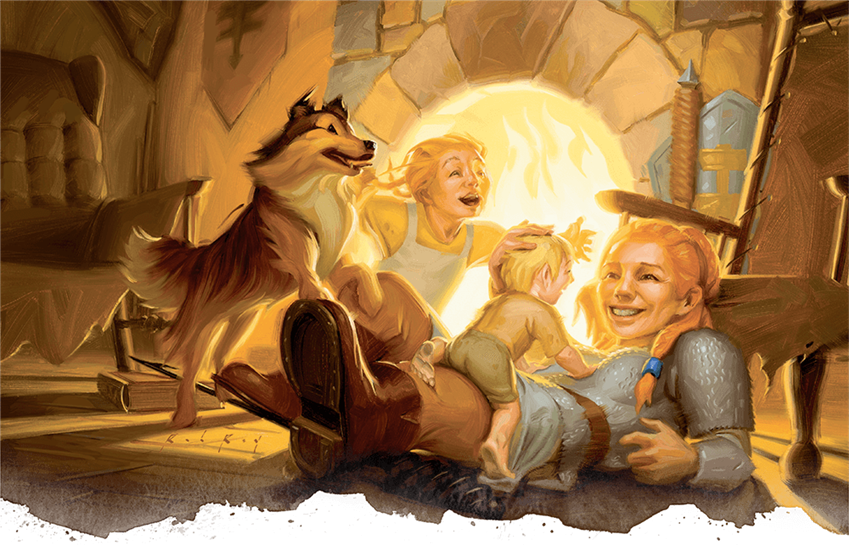Halflings worship a small number of original gods called the Vähän, but many of their gods and legends are actually incorporated from other faiths. Halflings do not have their own god of death, but they recognize demons and devils of other faiths as dangerous influences to be wary of.
Halflings who live in their own villages will generally worship Halfling gods or those on the list of Appropriated Gods. Those who live in communities very near elves or gnomes may also worship their gods. Halfling diaspora who live in cosmopolitan communities mixed with humans and other races are more likely to worship human gods. Of these, the gods of the Áes Camáir and the Zvire are more commonly worshipped than other human gods.
Gods Worshipped in Halfling Communities
Original Gods
Mother Ailish
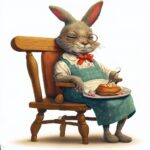 The de facto head of the Halfling pantheon is a four-foot tall anthropomorphized rabbit named Mother Ailish. She is depicted as a grandmotherly figure dressed in an apron, bifocal spectacles, and a bonnet or straw hat. When she isn’t shown knitting on her front stoop while dispensing common-sense wisdom, she’s generally shown baking in the kitchen. In her ovens she bakes any manner of delightful confections, particularly savory and sweet pies, and for this reason halflings celebrate natal days (and pretty much every occasion) with pies in her honor. It is said that she baked, piece by piece, all the non-living things of the world in her ovens and then fashioned them together. Every living this in the world is said to be descended from an original that she gave birth to – not in a live birth but laid in bright, multi-colored eggs that her many children and grandchildren (all also depicted as anthropomorphized rabbits) then hid about the world until they were ready to hatch and populate the world with life. For this reason, the halflings have a spring celebration in which they paint eggs made of paper, baked clay, wood, leather, or the like, inside which is hidden toys and candy, which are then exchanged with friends and family and sometimes hidden for strangers to find. Domains: Knowledge, Life, Nature, Forge, Order, Peace
The de facto head of the Halfling pantheon is a four-foot tall anthropomorphized rabbit named Mother Ailish. She is depicted as a grandmotherly figure dressed in an apron, bifocal spectacles, and a bonnet or straw hat. When she isn’t shown knitting on her front stoop while dispensing common-sense wisdom, she’s generally shown baking in the kitchen. In her ovens she bakes any manner of delightful confections, particularly savory and sweet pies, and for this reason halflings celebrate natal days (and pretty much every occasion) with pies in her honor. It is said that she baked, piece by piece, all the non-living things of the world in her ovens and then fashioned them together. Every living this in the world is said to be descended from an original that she gave birth to – not in a live birth but laid in bright, multi-colored eggs that her many children and grandchildren (all also depicted as anthropomorphized rabbits) then hid about the world until they were ready to hatch and populate the world with life. For this reason, the halflings have a spring celebration in which they paint eggs made of paper, baked clay, wood, leather, or the like, inside which is hidden toys and candy, which are then exchanged with friends and family and sometimes hidden for strangers to find. Domains: Knowledge, Life, Nature, Forge, Order, Peace
Lienne, the Lady of the Orchard
 Lienne is depicted as a tallfellow Halfling, though she may sometimes appear as human-sized or even taller, dressed in blue gowns with long, golden hair and flowers in her hair. She is generally shown in her gardens and orchards, and it is said that she will sometimes be found late and night wandering through halflings’ gardens given blessings to their crops. Domains: Life, Nature, Peace
Lienne is depicted as a tallfellow Halfling, though she may sometimes appear as human-sized or even taller, dressed in blue gowns with long, golden hair and flowers in her hair. She is generally shown in her gardens and orchards, and it is said that she will sometimes be found late and night wandering through halflings’ gardens given blessings to their crops. Domains: Life, Nature, Peace
Orson of the Grapes
 Orson is depicted as a particularly stout Halfling who generally rides a goat because Orson is too overweight to walk very far on his own. He is the god of unexpected good fortune, of blind luck, and many of the legends and tales about him are of good things inadvertently arising from his many accidents. He is usually tipsy but rarely very drunk, generally jolly but occasionally belligerent. His goat can get particularly feisty, and it is said that earthquakes and thunder are sometimes caused by his goat ramming into things. Domains: Tempest, Trickery, Twilight
Orson is depicted as a particularly stout Halfling who generally rides a goat because Orson is too overweight to walk very far on his own. He is the god of unexpected good fortune, of blind luck, and many of the legends and tales about him are of good things inadvertently arising from his many accidents. He is usually tipsy but rarely very drunk, generally jolly but occasionally belligerent. His goat can get particularly feisty, and it is said that earthquakes and thunder are sometimes caused by his goat ramming into things. Domains: Tempest, Trickery, Twilight
Appropriated Gods
Rígan Lúan
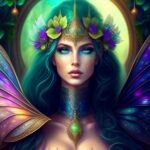 Halflings recognize Rígan Lúan, the Fairy Queen of the Áes Camáir, as one of the “Old Ones,” a group of powerful gods that predated even the halflings’ own gods of which for some reason only Rígan Lúan (in the halflings’ beliefs) remains. To them, she is a goddess of life and magic; her role in collecting the spirits of the dead as part of the Áes Camáir religion is not incorporated into the halflings’ religion. Domains: Arcana, Life, Light, Knowledge
Halflings recognize Rígan Lúan, the Fairy Queen of the Áes Camáir, as one of the “Old Ones,” a group of powerful gods that predated even the halflings’ own gods of which for some reason only Rígan Lúan (in the halflings’ beliefs) remains. To them, she is a goddess of life and magic; her role in collecting the spirits of the dead as part of the Áes Camáir religion is not incorporated into the halflings’ religion. Domains: Arcana, Life, Light, Knowledge
The Tinker
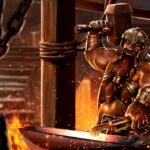 The dwarves call him Manikkam Kollan, the Maker or the Smith, but the halflings call him the Tinker. The halflings focus on his craftsmanship and his ability to create cunning little devices, and less on his ability to create great engineering marvels – and never on his weapons of war. His Halfling priests who remain respectably settled in Halfling villages only focus on his domains of Knowledge or Trickery, and the only clerics who focus on the domain of War are wanderers and adventurers. Those clerics typically retire in more cosmopolitan communities; the few who return to their Halfling homes will continue to openly worship the Tinker while being very circumspect about his domain of War. Domains: Forge, Knowledge, Trickery, War.
The dwarves call him Manikkam Kollan, the Maker or the Smith, but the halflings call him the Tinker. The halflings focus on his craftsmanship and his ability to create cunning little devices, and less on his ability to create great engineering marvels – and never on his weapons of war. His Halfling priests who remain respectably settled in Halfling villages only focus on his domains of Knowledge or Trickery, and the only clerics who focus on the domain of War are wanderers and adventurers. Those clerics typically retire in more cosmopolitan communities; the few who return to their Halfling homes will continue to openly worship the Tinker while being very circumspect about his domain of War. Domains: Forge, Knowledge, Trickery, War.
Lassamistra Ordymil
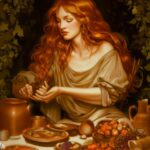 Many halflings revere the elven gods of the Estarine, but only Lassamistra Ordymil, the goddess of the hearth, has been formally “appropriated” into the Halfling pantheon. She is closely associated with domestic home life, including agriculture, the harvest, and livestock, and of magic that’s more helpful and practical like the mend, light, and mage hand spells, as well as other protective magic. She is also associated with the warm love of an enduring marriage or relationship. She is generally depicted as having auburn hair and brown skin with copper flecks. She is the patron of hearth and home, agriculture, marriage, fertility and motherhood, baking arts, weaving arts like tapestries, and drawing and painting. Domains: Arcana, Forge, Grave, Life, Nature, Order, Twilight
Many halflings revere the elven gods of the Estarine, but only Lassamistra Ordymil, the goddess of the hearth, has been formally “appropriated” into the Halfling pantheon. She is closely associated with domestic home life, including agriculture, the harvest, and livestock, and of magic that’s more helpful and practical like the mend, light, and mage hand spells, as well as other protective magic. She is also associated with the warm love of an enduring marriage or relationship. She is generally depicted as having auburn hair and brown skin with copper flecks. She is the patron of hearth and home, agriculture, marriage, fertility and motherhood, baking arts, weaving arts like tapestries, and drawing and painting. Domains: Arcana, Forge, Grave, Life, Nature, Order, Twilight
By Domain
- Arcana – Rígan Lúan, Lassamistra Ordymil
- Death – none
- Forge – The Tinker, Lassamistra Ordymil
- Grave – Lassamistra Ordymil
- Knowledge – Mother Ailish; Rígan Lúan; The Tinker
- Life – Mother Ailish; Lienne; Rígan Lúan; Lassamistra Ordymil
- Light – Rígan Lúan
- Nature – Lienne; Lassamistra Ordymil
- Order – Mother Ailish, Lassamistra Ordymil
- Peace – Mother Ailish, Lienne
- Tempest – Orson
- Trickery – Orson, The Tinker
- Twilight – Lassamistra Ordymil, Orson
- War – The Tinker

